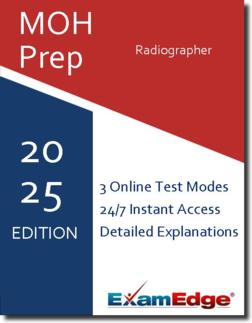MOH-Radiographer (-Radiographer) Practice Tests & Test Prep by Exam Edge - Topics
Based on 17 Reviews
- Real Exam Simulation: Timed questions and matching content build comfort for your MOH-Radiographer test day.
- Instant, 24/7 Access: Web-based MOH Radiographer practice exams with no software needed.
- Clear Explanations: Step-by-step answers and explanations for your MOH exam to strengthen understanding.
- Boosted Confidence: Reduces anxiety and improves test-taking skills to ace your MOH Radiographer (-Radiographer).

Understanding the exact breakdown of the MOH Radiographer test will help you know what to expect and how to most effectively prepare. The MOH Radiographer has multiple-choice questions The exam will be broken down into the sections below:
| MOH Radiographer Exam Blueprint | ||
|---|---|---|
| Domain Name | ||
| Patient Communication, Assessment, and Management | ||
| Drugs and Contrast Materials | ||
| Anatomy, Physiology, and Pathophysiology | ||
| Radiologic Procedures | ||
| Radiation Safety, Radiation Biology, and Fluoroscopic Operation | ||
| Medical-Legal, Professional, and Governmental Standards |


